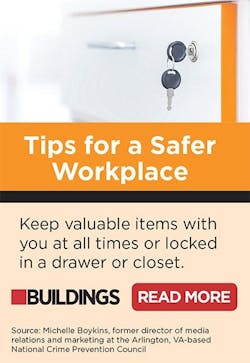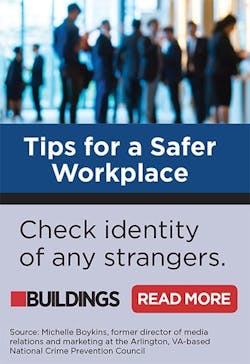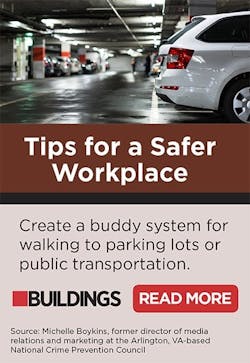Prevent Office Theft & Tips for a Safer Workplace
“Workplace theft is a huge problem; according to a survey by CNN, it’s the cause of failure for one in three businesses,” says Joe Mac McConnell, vice president of Cox Business Security Solutions in Atlanta, GA.
Download and share: Tips for a Safer Workplace
Building owners and facility managers need to equip themselves to fight office crime and protect their businesses with an integrated, careful approach. Find out who may be stealing from you, and how you can prevent it.
Who Would Steal Items from the Office?
The answer: anyone could. From serial thieves and desperate employees to cleaning staff or building visitors, the profile of an office thief varies.
“Theft in the workplace is a serious matter that’s on the rise for a large majority of facilities,” says Mark Hankewycz, principal at Maryland-based M2H Protection. “With the current economic downturn, incidents of theft – along with other criminal activity – are on the rise.”
People desperate to make ends meet, or with other money-consuming hobbies or addictions, might resort to office theft. “Perpetrators may include vendors, or even thieves off the street who find office buildings an easy mark,” says McConnell.
And, alarmingly, the U.S. Chamber of Commerce estimates that 75 percent of employees steal from the workplace, and that most do so repeatedly.
“Most crime can be reduced or stopped simply by reducing the opportunity for it,” says Hankewycz, describing the psychological effect that a lack of deterrence has. “Most criminals ‘case the joint’ before they commit a theft. If they feel there’s an opportunity for theft, and the chance is good that they can get away with it, they’ll likely commit the crime.”
What Gets Stolen in Office Thefts?
“Most often, we think of workplace theft as someone snatching money from a wallet or a purse,” says Michelle Boykins, former director of media relations and marketing at the Arlington, VA-based National Crime Prevention Council. “It can just as easily be an employee stealing office supplies or committing identity theft. We have to not only safeguard our property, but our information, too.”
Common items stolen in an office environment include items of value, like iPods, PDAs, and laptops; items of convenience, like pens, envelopes, CD-Rs, and other office supplies; and information or important data, either by taking the whole computer or moving the information onto a flash drive or CD.
Identity theft is increasing at an alarming pace.
According to the Federal Trade Commission, more than 9 million Americans have their identities stolen every year, and the losses to businesses and financial institutions total nearly $53 billion annually.
If your employees are leaving wallets containing credit cards on their desks, or are copying personal information on the copier, it’s only a matter of time before identities and accounts are compromised.
How to Prevent Office Thefts
Hire the right people.
The first step to preventing office theft is to hire the right people – people who won’t steal from you.
“One of the main strategies to stop the insider is performing background checks that aim to identify them before they’re hired,” says Hankewycz, who adds that periodic background checks should be performed in high-risk operations or businesses. “Criminals know what organizations perform background checks, and they stay away from them,” he says.
Find weaknesses in building security.
When you know you have the right people on your team, the next step is figuring out how secure your building is, and where potential weaknesses may be.
“Thus far, prevention [of office theft] has been an elusive achievement,” says McConnell. “Facilities managers and building owners can help with internal and external theft by conducting a security audit and developing a comprehensive security plan. The audit should examine the facility’s vulnerabilities, looking for ways to maximize safety and security, and minimize risks. Most security companies will conduct this type of audit at no cost.”
With the information from your security audit, you can reinforce or add security elements to aspects of your building that might be at risk.
3 Basic Solutions for Building Security
1. Access Control
“Electronic physical security (EPS) systems offer several solutions for the safeguarding of assets and personnel from unauthorized entrants into a workplace,” says Mark A. Visbal, a security and project management consultant.
[Related: New Hands-Free Access Control for Smartphone]
Visbal describes that EPS systems can include a card, a reader and an electronic locking device that controls the portal. Burglar alarms and radio frequency identification (RFID) tags are also included in EPS systems. “Each of these systems does a specific job when deployed by itself,” explains Visbal, “but there are synergistic benefits that occur when they’re integrated.”
Another aspect of access control includes where people are entering your building, and who is monitoring them.
“Visitors should only have access through one entrance and should be checked in by a lobby attendant or security guard,” says McConnell. “There are a number of simple and temporary badging solutions that provide visitors with badges that clearly identify them as a visitor while providing access for only a limited amount of time to limited areas.”
McConnell also encourages the presence of lobby attendants, receptionists and security guards who can greet each visitor and make eye contact, and warns against employees sharing access codes or keys with anyone.
2. Using Surveillance
Visbal explains that video systems in today’s buildings are analog (older technology) or digital, or a hybrid (where analog is being upgraded to digital).
“In these cases, the owner is looking to maximize his/her ROI on existing deployed components that haven’t reached the end of their useful life,” he says. Many video systems incorporate video analytics that detect motion, penetration of a secured area and objects left behind or moved.
“Some municipal law-enforcement agencies are requiring businesses to install and maintain video-surveillance systems,” says McConnell. If the surveillance system can record, the footage can be very useful in determining when a crime occurred and who was involved.
In addition to recording events, video surveillance has a psychological impact. Visible cameras and signage are effective deterrents to office crime.
Forming an “office watch” group will also reinforce workplace surveillance.
3. Training Employees and Occupants
“The security course usually is less than one hour and will cover common issues, such as workplace violence, use of company ID cards and general security-awareness items. We commonly see this training given by the facility director or security manager,” he says.
For larger facilities with many employees, a podcast or training video may make more sense than group training sessions.
If you have a good handle on access control, surveillance and proper training, your workplace will be reasonably safe, but don’t fall into the trap of complacency. Paying attention to details might save you and your employees from victimization.
“Consider extra security measures, such as security cables for laptops,” says McConnell. “This fairly inexpensive solution can keep creepers from walking away with laptops and valuable company data.”
Shredding papers and documents is another smart practice for avoiding identity theft.
You should also keep your building occupants tuned in to security.
“If you receive information on local commercial crime, it’s important to share that information with employees and tenants via bulletins, e-mail newsletters, etc.,” says McConnell. “Informed employees are essential to effective building security.”
Jenna M. Aker is a former associate editor at BUILDINGS. This article was published in 2009 and updated in 2018 by Sarah Kloepple.
Two handpicked articles to read next:



